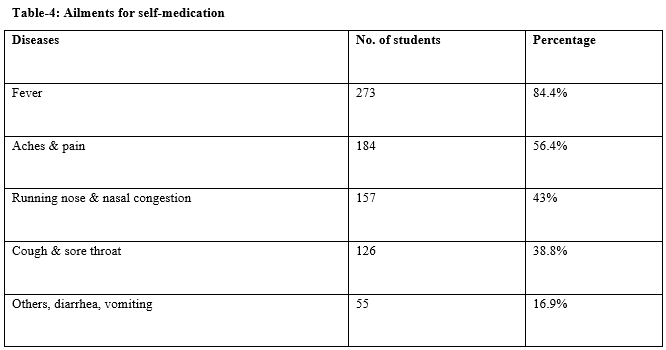Prevalence and pattern of self-medication among medical students of a private medical college in Kerala
Abstract
Introduction: Self-medication is defined as medication taken on one's own initiative or on the advice of pharmacist or any other lay person. It is one of the leading cause for the ever threatening drug resistance for various drugs. Medical students are future physicians and prescribers. It is important to know how they use medicines and what the pattern is. Hence, assessing their practice on this sensitive issue will help in planning interventions to prevent irrational use of medicines.
Objective: To determine the prevalence and pattern of self-medication among medical students.
Methods: A cross-sectional study was done among the medical students of a private college in Central Kerala using a pre - tested semi-structured questionnaire which had questions regarding common drugs used for self-medication, ailments, reasons, source & also awareness about dose, course & side effects of the drug used.
Results: Prevalence of self-medication was 95%. Commonly self-medicated drugs include antipyretics 253(78.06%) and analgesics 158(58.8%). Diseases which are commonly self-medicated are fever 273(84.4%) and aches & pain 184(56.4%). Majority of students were self-medicating due to mild nature of illness 236(72.9%). Common source of self-medicated drugs were pharmacy for 248(76.5%), family &friends for 137(42.2%).
Conclusions: Prevalence of self-medication was found to be very high among medical students. Considering the fact that the respondents are future prescribers, correct, timely use of drugs need to be stressed. But they were using the drugs only for common ailments and not for serious diseases.
Downloads
References
2. Bradley C, Blenkinsopp A. Over the counter drugs: the future for self-medication. BMJ 1996 Mar 30; 312(7034):835-7.
3. World Health Organization/Drug Action Program (WHO/DAP). Public Education in Rational Drug Use; Report of an Informal Consultation, 23-26 November 1993, Geneva.
4. Gore P.R, Mahavan S. Consumers' Preference and Willingness to Pay for Pharmacist Counselling for Non-prescription Medicines. J Clinical Pharmacy and Therapeutics; 1994; 19(1):17-25.
5, Hughes CM, McElnay JC, Fleming GF. Benefits and risks of self-medication. Drug Saf. 2001;24:1027-37.
6. Hem E, Stokke G, Tyssen R, Gronvold NT, Vaglum P, Ekeberg O. Self-prescribing among young Norwegian doctors: a nine-year follow-up study of a nationwide sample. BMC Med. 2005;3:16. DOI: 10.1189/1741-7015-3-16.
7. Donkor ES, Tetteh-Quarcoo PB, Nartey P, Agyeman IO. Self-medication practices with antibiotics among tertiary level students in Accra, Ghana: a cross-sectional study. J. Environ Res. Public Health2012 Oct 5; 9(10): 3519-29. DOI: 10.3390/ijerph9103519.
8. Badiger S, Kundapur R, Jain A, Kumar A, Pattanshetty S, Thakolkaran N, Bhat N, Ullal N. Self-medication patterns among medical students in South India. Australas Med J 2012;5(4): 217-20. DOI: 10.4066/AMJ.2012.1007.
9. Banerjee I, Bhadury T. Self-medication practice among undergraduate medical students in a tertiary care medical college. J Postgrad Med. 2012 Apr-Jun; 58(2): 127-31. DOI: 10.4103/0022-3859.97175.
10. Kumar N, Kanchan T, Unnikrishnan B, Rekha T, Mithra P, Kulkarni V, Papanna MK, Holla R, and Uppal S. Perceptions and Practices of Self-Medication among Medical Students in Coastal South India. PLoS One. 2013; 8(8): e77247. DOI: 10.1371/journal.pone.0072247.
11. Pandya RN, Jhaveri KS, Vyas FI, Patel VJ. Prevalence, pattern and perceptions of self-medication in medical students. Int J Basic & Clinical Pharmacology 2013;2(3):275-80. DOI: 10.5455/2319-2003.
12. Zafar SN, Syed R, Waqar S, Zubairi AJ, Vaqar T, Shaikh M, Yousaf W, Shahid S, Saleem S. Self-medication amongst university students of Karachi: Prevalence, knowledge and attitudes. J Pak Med Assoc 2008;58(4):214-7.
13. El Ezz NFA, Ez-Elarab HS. Knowledge, attitude and practice of medical students towards self-medication at Ain Shams University, Egypt. J Prev Med Hyg 2011;52 (4) 196-200.
14. James H, Handu SS, Al Khaja KA, Otoom S, Sequeira RP. Evaluation of the knowledge, attitude and practice of self-medication among first-year medical students. Med Princ Pract 2011;15 (4): 270-5.

Copyright (c) 2016 Author (s). Published by Siddharth Health Research and Social Welfare Society

This work is licensed under a Creative Commons Attribution 4.0 International License.


 OAI - Open Archives Initiative
OAI - Open Archives Initiative


